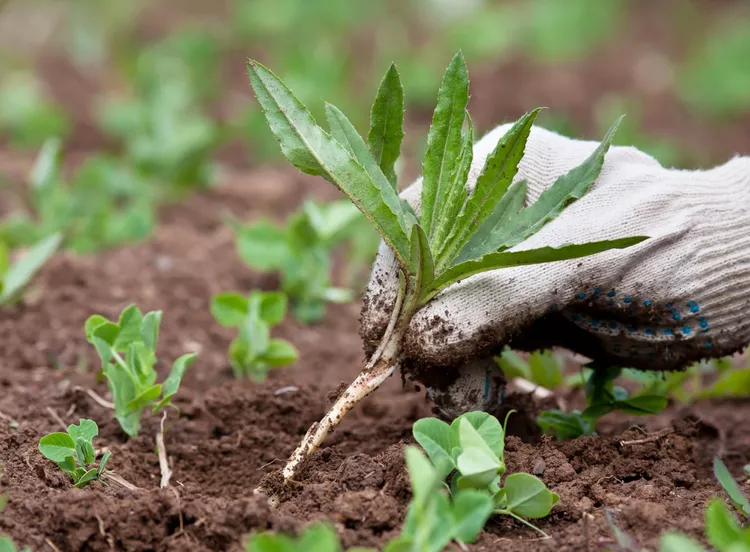For most gardeners, weeding isn't exactly a favorite chore. It sure can feel like an endless (and maybe even a losing) battle during the growing season. Yet, a weed-free garden looks neat and tidy, especially right after a big weeding session. Plus, regularly getting rid of weeds goes well beyond aesthetics because these garden invaders compete with your plants for water, nutrients, and light.
If left unattended, aggressive weeds can totally overrun a bed, smothering your favorite flowers or vegetables. Some weeds also can give diseases and pests a foothold to spread to your cultivated plants. Make things easier on yourself by avoiding these common weeding mistakes.
1. Not knowing the enemy.
Identifying the weeds in your garden can help you figure out the best strategy for controlling them. "One key aspect I encounter with gardeners trying to win the battle with weeds is not knowing what the weed is or anything about it," says North Carolina Extension Agent Alison Arnold. "Being able to identify the weed will give information on how to manage it."
For starters, it helps to know if you are dealing with an annual, perennial, or biennial weed. Annuals can often be controlled by cutting them to the ground before they seed, while perennials and some biennials treated in this manner will simply grow back from the roots. It also helps to learn how particular weeds spread (by seed, runners, suckers, etc.), when they flower, and when the seeds tend to germinate.
2. Forgetting those seeds.
Many weeds spread by producing tons of seeds, which often can survive in the soil for many years, just waiting for a bit of light and moisture to grow. When you're weeding, keep this in mind so that you disturb the soil as little as possible. Applying a layer of mulch will also help prevent the weed seeds from seeing the light of day.
Weeding before seeds are set can go a long way toward reducing future weeds. Pre–emergent herbicides, designed to kill germinating seeds in the soil, can be an effective control. Still, they also prevent germination of desirable seeds, so don't use them where you plan to over-seed a lawn, for example.
3. Misusing herbicides.
There are many kinds of weed killers beyond pre-emergents; all should be used with caution and according to the instructions on the label. Never spray on a windy day, and wear protective clothing when applying it (mask, eye protection, gloves, long-sleeved shirt, long pants, socks, and closed-toe shoes).
Make sure to use a suitable herbicide for your particular needs. Some herbicides are selective, meaning some kill only grasses, while others kill only broadleaf plants. Non-selective herbicides kill any plant they are sprayed upon. Label your sprayer so you don't use it for anything else. Even a little herbicide residue can seriously injure your garden plants.
4. Using the wrong weeding tool.
You might be tempted to use a weed whacker on everything, but that's not the best solution for all weeds or garden situations. "For annual weeds, such as chickweed, purslane, and lamb's quarters, cut off the weed at the soil line with a sharp hoe. Don't dig too deep into the soil, or you'll bring up more weed seeds, resulting in more work for you," says Charlie Nardozzi, host of the All Things Gardening radio show. A long-handle hoe works well in the vegetable garden, while a hand hoe is great for weeding in tight, crowded spots or raised beds.
"For perennial weeds, such as dandelions and burdock, wait until the soil is wet; use a cultivator meant to dig deep to get these taproots, and try not to leave any roots behind. It will save you re-weeding that weed later," says Nardozzi. Good hand tools for digging perennial roots include a hori-hori knife and a dandelion weeder.
5. Forgetting gloves.
Adding insult to injury, some weeds, such as thistle and wild blackberry, have prickles. Some weeds, such as stinging nettle and poison ivy, may cause skin irritation. Avoid painful punctures and rashes, especially when working with unfamiliar plants, by always wearing protective gloves while weeding.
6. Relying on landscape fabric.
Landscape fabric topped with mulch has been touted as a long-term solution to control weeds. It can be effective in pathways, under play sets, or other spaces where you aren't growing plants. But if used in annual flowerbeds or vegetable gardens, you'll likely need to replace it each year, and it will get in the way of adding compost or other soil enhancements fast-growing annual plants often need.
Landscape fabric will make weeding harder in the long run for permanent plantings such as shrub borders or perennial gardens. Soil and organic debris will accumulate in the mulch on top of the fabric, providing weed seeds that blow in a perfect spot to germinate and grow. As time goes by, the material begins to break down, so weed roots can penetrate the soil and be more challenging to dig up because of the barrier. Removing landscape fabric after it has lost effectiveness is a far more arduous chore than regularly weeding the area.
7. Procrastinating.
The longer weeds grow, the more they spread, and small weeds are much easier to remove than big ones. Pull them as soon as you spot them growing, saving time and effort. Kathy Purdy at ColdClimateGardening.com says this is especially true of woody weeds. "Putting off pulling woody seedlings of trees and shrubs is a big mistake. Before you know it, you have to dig deeply to get out the root, and if you don't get it all, some woody plants will send up suckers, becoming an ongoing problem," she explains.
So grab your gloves, comfy gardening stool, the right tools, and get to it! When it comes to weeding, delaying this important task is always a mistake.




















